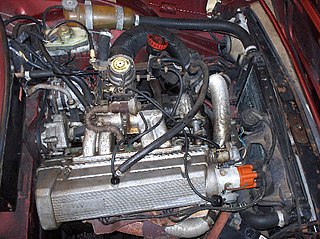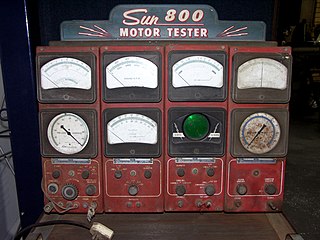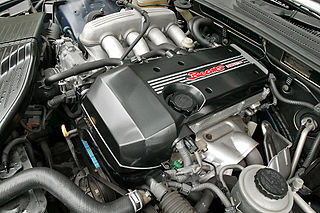
The compression ratio is the ratio between the volume of the cylinder and combustion chamber in an internal combustion engine at their maximum and minimum values.

A two-strokeengine is a type of internal combustion engine that completes a power cycle with two strokes of the piston during one power cycle, this power cycle being completed in one revolution of the crankshaft. A four-stroke engine requires four strokes of the piston to complete a power cycle during two crankshaft revolutions. In a two-stroke engine, the end of the combustion stroke and the beginning of the compression stroke happen simultaneously, with the intake and exhaust functions occurring at the same time.

In internal combustion engines, exhaust gas recirculation (EGR) is a nitrogen oxide (NOx) emissions reduction technique used in petrol/gasoline, diesel engines and some hydrogen engines. EGR works by recirculating a portion of an engine's exhaust gas back to the engine cylinders. The exhaust gas displaces atmospheric air and reduces O2 in the combustion chamber. Reducing the amount of oxygen reduces the amount of fuel that can burn in the cylinder thereby reducing peak in-cylinder temperatures. The actual amount of recirculated exhaust gas varies with the engine operating parameters.

A four-strokeengine is an internal combustion (IC) engine in which the piston completes four separate strokes while turning the crankshaft. A stroke refers to the full travel of the piston along the cylinder, in either direction. The four separate strokes are termed:
- Intake: Also known as induction or suction. This stroke of the piston begins at top dead center (T.D.C.) and ends at bottom dead center (B.D.C.). In this stroke the intake valve must be in the open position while the piston pulls an air-fuel mixture into the cylinder by producing a partial vacuum in the cylinder through its downward motion.
- Compression: This stroke begins at B.D.C, or just at the end of the suction stroke, and ends at T.D.C. In this stroke the piston compresses the air-fuel mixture in preparation for ignition during the power stroke (below). Both the intake and exhaust valves are closed during this stage.
- Combustion: Also known as power or ignition. This is the start of the second revolution of the four stroke cycle. At this point the crankshaft has completed a full 360 degree revolution. While the piston is at T.D.C. the compressed air-fuel mixture is ignited by a spark plug or by heat generated by high compression, forcefully returning the piston to B.D.C. This stroke produces mechanical work from the engine to turn the crankshaft.
- Exhaust: Also known as outlet. During the exhaust stroke, the piston, once again, returns from B.D.C. to T.D.C. while the exhaust valve is open. This action expels the spent air-fuel mixture through the exhaust port.

In an internal combustion engine, the cylinder head sits above the cylinders and forms the roof of the combustion chamber. In sidevalve engines, the head is a simple sheet of metal; whereas in more modern overhead valve and overhead camshaft engines, the cylinder head is a more complicated block often containing inlet and exhaust passages, coolant passages, valves, camshafts, spark plugs and fuel injectors. Most straight engines have a single cylinder head shared by all of the cylinders and most V engines have two cylinder heads.

Engine tuning is the adjustment or modification of the internal combustion engine or Engine Control Unit (ECU) to yield optimal performance and increase the engine's power output, economy, or durability. These goals may be mutually exclusive; an engine may be de-tuned with respect to output power in exchange for better economy or longer engine life due to lessened stress on engine components.

A hemispherical combustion chamber is a type of combustion chamber in a reciprocating internal combustion engine with a domed cylinder head notionally in the approximate shape of a hemisphere. An engine featuring this type of hemispherical chamber is known as a hemi engine.
A combustion chamber is part of an internal combustion engine in which the fuel/air mix is burned. For steam engines, the term has also been used for an extension of the firebox which is used to allow a more complete combustion process.

The Ford 335 engine family was a group of engines built by the Ford Motor Company between 1969 and 1982. The "335" designation reflected Ford management's decision to produce an engine of that size with room for expansion during its development. This engine family began production in late 1969 with a 351 cu in (5.8 L) engine, commonly called the 351C. It later expanded to include a 400 cu in (6.6 L) engine which used a taller version of the engine block, commonly referred to as a tall deck engine block, a 351 cu in (5.8 L) tall deck variant, called the 351M, and a 302 cu in (4.9 L) engine which was exclusive to Australia.

The LA engines are a family of pushrod OHV small-block 90° V-configured gasoline engines built by Chrysler Corporation. They were factory-installed in passenger vehicles, trucks and vans, commercial vehicles, marine and industrial applications from 1964 through 2003. Their combustion chambers are wedge-shaped, rather than polyspherical, as in the predecessor A engine, or hemispherical in the Hemi. LA engines have the same 4.46 in (113 mm) bore spacing as the A engines.

In automotive engineering a multi-valve or multivalve engine is one where each cylinder has more than two valves. A multi-valve engine has better breathing and may be able to operate at higher revolutions per minute (RPM) than a two-valve engine, delivering more power.

A flathead engine, also known as a sidevalve engine or valve-in-block engine, is an internal combustion engine with its poppet valves contained within the engine block, instead of in the cylinder head, as in an overhead valve engine.
Lean-burn refers to the burning of fuel with an excess of air in an internal combustion engine. In lean-burn engines the air–fuel ratio may be as lean as 65:1. The air / fuel ratio needed to stoichiometrically combust gasoline, by contrast, is 14.64:1. The excess of air in a lean-burn engine emits far less hydrocarbons. High air–fuel ratios can also be used to reduce losses caused by other engine power management systems such as throttling losses.

The Chrysler Hemi engines, known by the trademark Hemi or HEMI, are a series of American V8 gasoline engines built by Chrysler with overhead valve hemispherical combustion chambers. Three different types of Hemi engines have been built by Chrysler for automobiles: the first from 1951 to 1958, the second from 1964 to 1971, and the third beginning in 2003. Although Chrysler is most identified with the use of "Hemi" as a marketing term, many other auto manufacturers have incorporated similar designs. The engine block and cylinder heads were cast and manufactured at Indianapolis Foundry.
Homogeneous Charge Compression Ignition (HCCI) is a form of internal combustion in which well-mixed fuel and oxidizer are compressed to the point of auto-ignition. As in other forms of combustion, this exothermic reaction produces heat that can be transformed into work in a heat engine.

The Toyota S Series engines are a family of straight-4 petrol or CNG engines with displacement from 1.8 L to 2.2 L produced by Toyota Motor Corporation from January 1980 to August 2007. The series has cast iron engine blocks and aluminium cylinder heads.

A model engine is a small internal combustion engine typically used to power a radio-controlled aircraft, radio-controlled car, radio-controlled boat, free flight, control line aircraft, or ground-running tether car model.
The following outline is provided as an overview of and topical guide to automobiles:

An internal combustion engine is a heat engine in which the combustion of a fuel occurs with an oxidizer in a combustion chamber that is an integral part of the working fluid flow circuit. In an internal combustion engine, the expansion of the high-temperature and high-pressure gases produced by combustion applies direct force to some component of the engine. The force is typically applied to pistons, turbine blades, a rotor, or a nozzle. This force moves the component over a distance, transforming chemical energy into kinetic energy which is used to propel, move or power whatever the engine is attached to.
An oil catch tank or oil catch can is a device that is fitted into the cam/crankcase ventilation system on a car. Installing an oil catch tank (can) aims to reduce the amount of oil vapors re-circulated into the intake of the engine.














